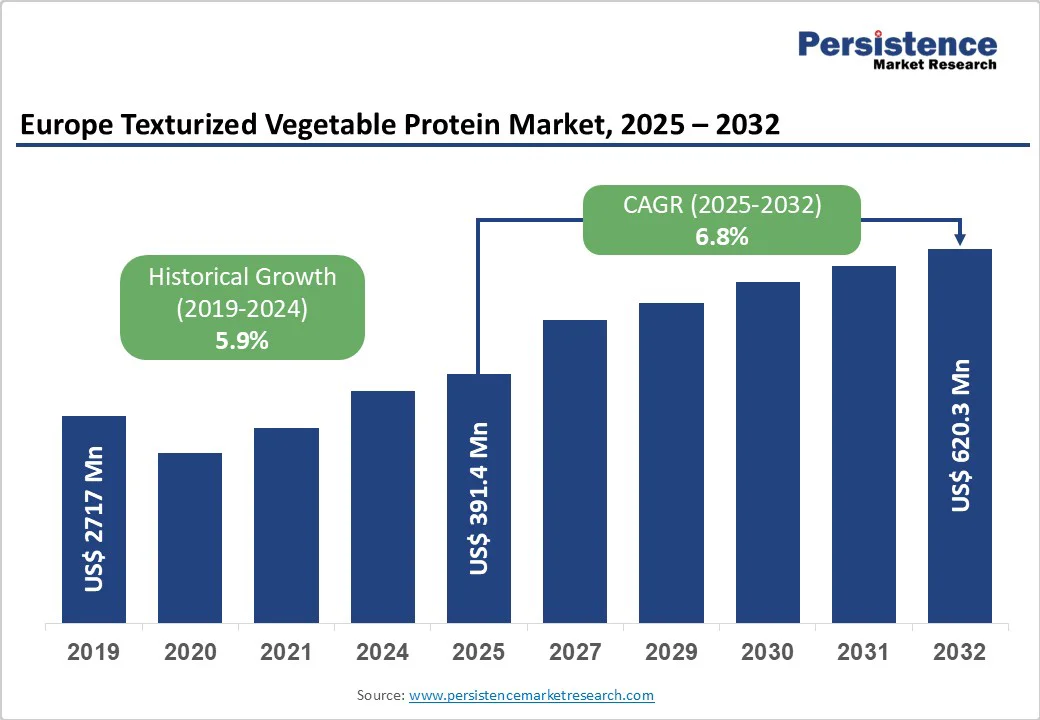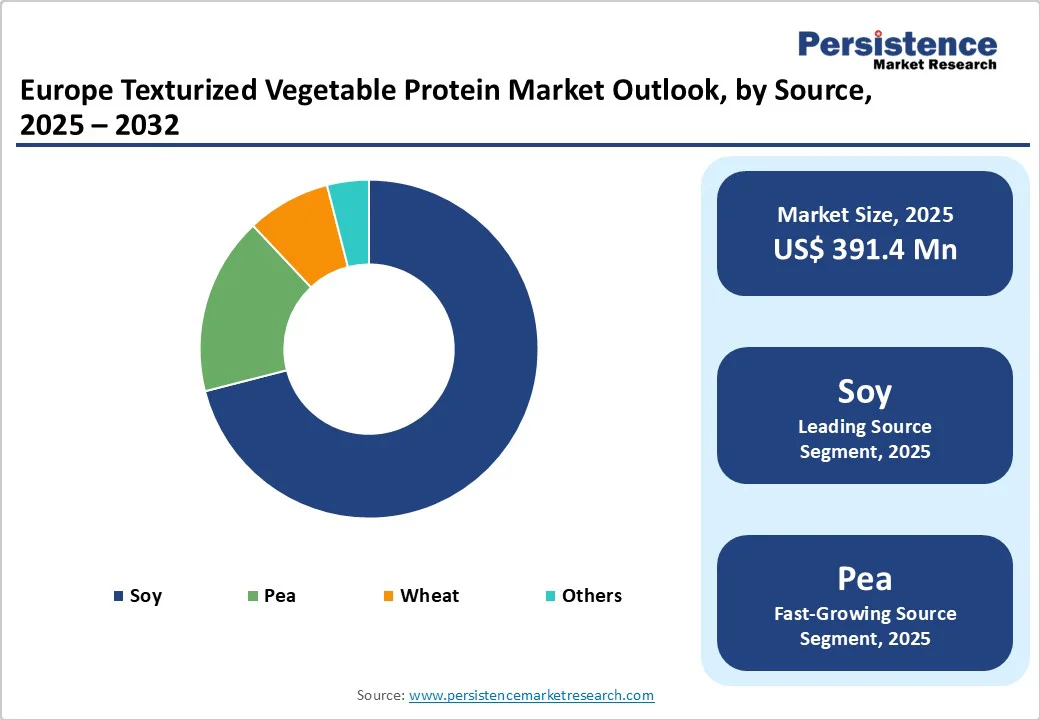ID: PMRREP35687| 189 Pages | 7 Oct 2025 | Format: PDF, Excel, PPT* | Food and Beverages

Europe texturized vegetable protein market size is likely to value US$ 391.4 million in 2025 and projected to reach US$ 620.3 million by 2032, growing at a CAGR of 6.8% during the forecast period from 2025 to 2032.
| Key Insights | Details |
|---|---|
|
Texturized Vegetable Protein Market Size (2025E) |
US$ 391.4 Mn |
|
Market Value Forecast (2032F) |
US$ 620.3 Mn |
|
Projected Growth (CAGR 2025 to 2032) |
6.8% |
|
Historical Market Growth (CAGR 2019 to 2024) |
5.9% |

An intriguing shift in eating habits is reshaping Europe’s food industry, with the flexitarian diet gaining strong traction and fueling demand for texturized vegetable proteins (TVP). As per Glanbia Nutritionals, one in three consumers in Europe now identify as flexitarian, signaling a broader trend toward reduced meat intake without full commitment to veganism or vegetarianism. This rise reflects growing awareness of sustainability, animal welfare, and health-conscious living. TVP, made from soy, peas, or wheat, is increasingly used by food manufacturers to create versatile meat alternatives that fit seamlessly into European cuisines, from pasta sauces in Italy to ready meals in Germany. The affordability, protein density, and adaptability of TVP make it a favored option for both consumers and manufacturers seeking balance between taste and sustainability. With millennials and Gen Z driving this trend, the flexitarian shift ensures TVP will remain central to Europe’s evolving protein landscape.
A crowded protein innovation space is creating mounting pressure on the Europe texturized vegetable protein (TVP) market. As consumer interest in sustainable and high-quality protein grows, alternatives such as mycoprotein, insect protein, cultured meat, and algae-based proteins are rapidly gaining visibility. These options appeal to health-conscious and eco-driven consumers seeking diversity beyond traditional soy or pea-based TVP. Mycoprotein, in particular, has carved a strong niche in the U.K. and other European markets, while cultured meat initiatives in the Netherlands and Spain attract increasing investment.
The variety of sensory experiences and nutritional claims offered by these alternatives makes competition more intense for TVP producers. With regulatory frameworks in Europe progressively accommodating novel proteins, the competitive landscape is widening. This shift forces TVP manufacturers to focus on innovation, taste enhancement, and clean-label positioning to retain consumer preference amidst the growing array of protein choices.
Unlocking access to EU-backed financial instruments presents a major growth pathway for companies in Europe texturized vegetable protein (TVP) market. Programs such as Horizon Europe and the European Innovation Council provide targeted grants to scale R&D and accelerate sustainable food production technologies. TVP manufacturers that tap into these funds can expand pilot projects into full-scale facilities, optimize extrusion technologies, and explore novel raw materials such as fava beans or lupin.
Horizon Europe’s focus on climate-neutral food systems aligns directly with TVP’s positioning as a sustainable protein alternative, making the category well-placed to attract funding. Moreover, public-private collaborations supported through EU frameworks foster partnerships between startups, research institutions, and established food companies. By leveraging these grants, TVP producers can shorten innovation cycles, reduce capital costs for advanced facilities, and reinforce Europe’s leadership in the transition toward more sustainable and diversified protein supply chains.
Soy holds approximately 71% of the Europe Texturized Vegetable Protein (TVP) market share as of 2024. This dominance is attributed to soy's high protein content, cost-effectiveness, and versatility in various food applications. Soy-based TVP is widely used in meat alternatives, ready meals, and snacks, aligning with the growing consumer demand for plant-based proteins. The European market benefits from a robust supply chain, with significant imports of soybeans, primarily from the United States and Brazil, ensuring a steady raw material supply for TVP production. Additionally, soy's established presence in the food industry, coupled with its favorable nutritional profile, reinforces its leading position in the market. As consumer preferences shift towards sustainable and health-conscious food choices, soy-based TVP continues to be a preferred ingredient, supporting its substantial market share in Europe's evolving food landscape.
Organic Texturized Vegetable Protein is expected to grow at a CAGR of 9.7% during the forecast period 2025–2032, reflecting increasing consumer focus on health, sustainability, and plant-based diets across Europe. Rising awareness about the benefits of organic ingredients, including reduced exposure to pesticides and enhanced nutritional quality, is driving demand among health-conscious and environmentally aware consumers. Organic TVP, derived from soy, peas, and other legumes, offers a versatile protein source for meat alternatives, ready-to-eat meals, and snacks, catering to flexitarian, vegetarian, and vegan populations.
Regulatory support for organic certification and clean-label products in the EU further strengthens market prospects. Manufacturers are investing in advanced processing technologies to ensure consistent texture, flavor, and protein retention, enhancing product appeal. The convergence of organic trends with sustainability concerns, coupled with growing interest in plant-based nutrition, positions organic TVP for significant expansion, creating opportunities for suppliers to innovate and capture premium market segments.

Germany dominates Europe Texturized Vegetable Protein (TVP) Market, holding 38% market share as of 2024, reflecting its strong industrial base and high consumer acceptance of plant-based proteins. The country’s robust processed food and convenience meal sectors increasingly incorporate TVP to meet evolving dietary preferences. Flexitarian eating habits are particularly influential, with 42% of German consumers identifying as flexitarian, signaling a shift toward reduced meat consumption while maintaining protein intake.
Soy- and pea-based TVP products are widely adopted in meat alternatives, ready-to-eat meals, and snack applications, offering consistent texture, high protein content, and cost efficiency for manufacturers. Germany’s regulatory support for sustainable and plant-based foods, along with widespread consumer awareness of health and environmental impacts, further propels TVP demand. Continuous innovation in extrusion technologies and clean-label formulations enables producers to develop versatile, flavorful, and process-stable TVP products, reinforcing Germany’s leadership position in Europe’s growing alternative protein landscape.
UK texturized vegetable protein market is experiencing steady growth, driven by a rising preference for plant-based diets and sustainable protein alternatives. Consumers, particularly millennials and Gen Z, are increasingly adopting flexitarian and vegetarian lifestyles, seeking convenient, high-protein foods that align with health and environmental values. Ready-to-eat meals, meat analogues, and snacks incorporating TVP are witnessing higher adoption, supported by the expanding fast-casual and retail food sectors. Clean-label and allergen-friendly formulations further enhance TVP appeal, with soy, pea, and wheat-based variants leading the market. Companies like Whole Food Earth® are leveraging these trends by offering plant-based meat alternatives that combine taste, texture, and nutritional value, catering to both retail and foodservice channels. Innovation in extrusion technology and product development continues to strengthen market offerings, positioning TVP as a core ingredient in the UK’s evolving protein landscape while responding to regulatory encouragement for sustainable food systems.
Europe texturized vegetable protein (TVP) market is driven by both established ingredient suppliers and emerging plant-based innovators. Companies are increasingly adopting advanced extrusion and processing technologies to improve texture, flavor, and nutritional quality, meeting the expectations of a growing flexitarian consumer base. Online retail channels are expanding their reach, allowing smaller players to access niche markets while established brands strengthen their omnichannel presence. Regulatory support from the European Union, alongside funding programs such as Horizon Europe, enables manufacturers to invest in R&D and scale sustainable production.
The clean-label movement further influences product development, as consumers demand minimally processed, natural ingredients with transparent sourcing. Strategic collaborations, technological innovation, and responsiveness to evolving dietary trends define competitive positioning, allowing TVP producers to differentiate themselves in a market where sustainability, convenience, and functional performance are key to capturing long-term growth and consumer loyalty.
The Europe market is projected to be valued at US$ 391.4 Mn in 2025.
Growing flexitarian diet growth drives Europe Texturized Vegetable Protein market.
Europe market is poised to witness a CAGR of 6.8% between 2025 and 2032.
Leveraging EU grants & Horizon Europe funding to scale alternative protein R&D and production facilities is the key market opportunity for players in Europe texturized vegetable protein market.
ADM, Cargill, Incorporated, IFF, Ingredion, dsm-firmenich, Roquette Frères, A&B Ingredients, Inc., and others are some of the key players.
| Report Attribute | Details |
|---|---|
|
Historical Data/Actuals |
2019 - 2024 |
|
Forecast Period |
2025 - 2032 |
|
Market Analysis |
Value: US$ Mn |
|
Geographical Coverage |
|
|
Segmental Coverage |
|
|
Competitive Analysis |
|
|
Report Highlights |
|
By Source
By Nature
By End-use
By Sales Channel
By Region
Delivery Timelines
For more information on this report and its delivery timelines please get in touch with our sales team.
About Author